Explore Sockalingum Meenatchee Ammen Kovil In Mauritius For Your 2026 Vacay
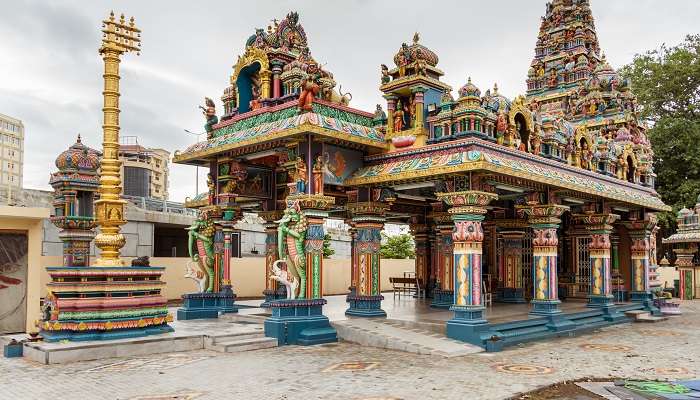
Mauritius is often known for its beautiful beaches and shoreline. However, if you want to experience the real essence of this tiny island nation, you need to visit temples like Sockalingum Meenatchee Ammen Kovil. The temple showcases the vibrant heritage of Mauritius. It is a testament to the Hindu links to the country’s culture, signifying an enduring spirit of the religious diversity found here. The temple is one of the oldest and most significant complexes that should be on your list while travelling to Mauritius. Let’s explore more about it.
Overview Of Sockalingum Meenatchee Ammen Kovil

Sockalingum Meenatchee Ammen Kovil is a Tamil temple located in Port Louis, at VG29+3MQ, Port Louis, Mauritius. As per the history of the nations, many immigrants came and settled on the island. Hindus were among the most iconic ones. This is why they brought with them a rich culture, brilliant architecture, and age-old heritage. All of this is easily depicted at this temple.
Sockalingum Meenatchee Ammen Kovil stands as a sign of the belief and religious essence of Hinduism and their deep-rooted faith. The temple features ornate interiors along with bold colours. What’s more striking is the intricately carved statues that form the trademark of this temple. Like other Hindu temples of Southern India, this temple also has various sections like Gopulapuram, altars, entrances, etc.
Must Read: Tamarind Falls
History Of Sockalingum Meenatchee Ammen Kovil Temple
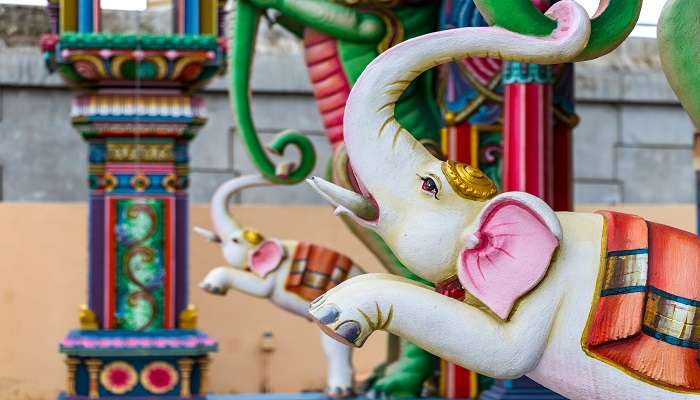
As per the history of the Sockalingum Meenatchee Ammen Kovil Temple, Tamil traders on the island built the Kaylasson Temple in 1854. When it comes to structures intended to be places of worship, the Dravidian architectural style is followed. Indian artisans created each of the temple’s traditional embellishments by hand. The Sockalingum Meenatchee Ammen Kovil was constructed in phases. Construction started as early as 1854 when Indian craftsmen came. In 1860, the temple and its arcades were dedicated. Following the vestibule’s completion in 1868, the artisans returned to India.
Certain historians believe Hindus already resided in Mauritius when the French colonised the island nation in 1715. Mauritius saw a large influx of immigrants during this time, including the Indian Tamil Hindus. Their culture and religion came with them when they arrived. However, before 1850, there were no Hindu temples on the island. The first temple was constructed in that year, and the rich influence of Hindu culture on Mauritius began. The Sockalingum Meenatchee Ammen Kovil Temple is a sheer example of that.
Temple Architecture
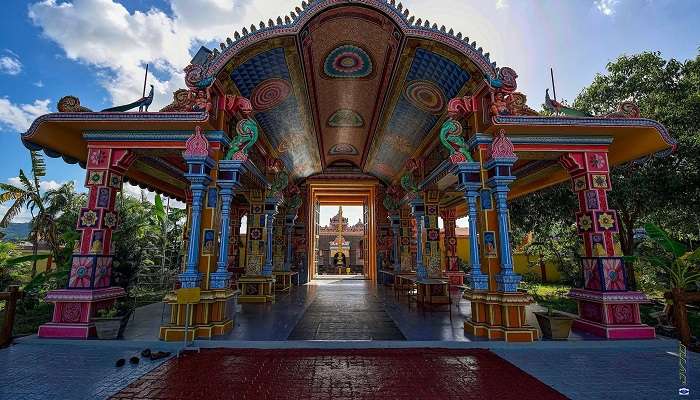
The architectural style of Bengal is mirrored in theSockalingum Meenatchee Ammen Kovil. For example, the main temple is built in a West Bengali “ratna” style. It is a five-towered temple on a platform, similar to a pancha-ratna. Images of several Hindu deities and floral patterns adorn the temple. The temple has been painted white ever since it was built, but the sculptures and floral patterns stand out against the white background. Lord Shiva resides in the main temple as the Shiv Ling. The depiction of his spouse, the goddess Parvati, their sons, Lord Ganesha and Lord Kartikeya and Lord Bhairava, another manifestation of Shiva, is also established here. Nandi, the gatekeeper, is facing the Shiv Ling.
Two smaller temples are next to the main one, honouring Lord Nataraja and the goddess Lakshmi. A different temple honours Lakshmi Narayan and all of their incarnations. In addition to the temple dedicated to Lord Jagannath, goddesses Kali, Saraswati, Durga and her nine forms, there is also a shrine dedicated to Hanuman. The tiny temple in the middle of the complex is called Kashi Vishwanath and houses the smaller lingam that Pandit Sajibon brought from Kashi.
Suggested Read: Paragliding In Mauritius
Heritage Of Sockalingum Meenatchee Ammen Kovil
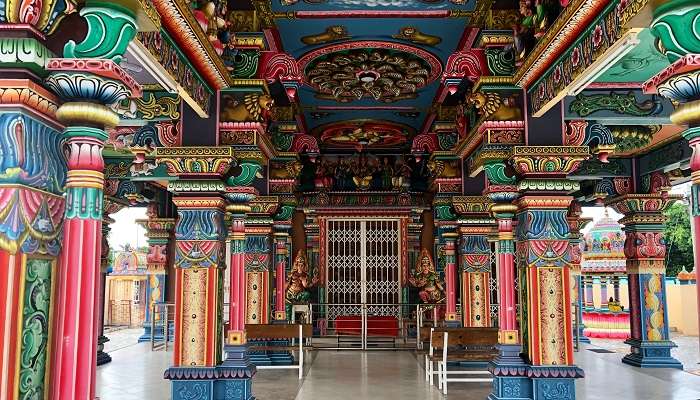
As a National Heritage site, it provides a genuine chance to experience Tamil culture in all its majesty. Here, you can witness the exquisitely crafted statues, array of colours, and bas-reliefs attest to the commitment and expertise of Indian artisans and other labourers in 1854.
One of the most significant Tamil holidays, Thaipoosam Cavadee, honours the triumph of Muruga, son of Shiva, over evil and its focal point is the Meenatchee Ammen Kovil. Here, the god is honoured with a monthly celebration. A major ritual is followed in honour of deities, called the Thaipoosam Cavadee. The ceremony takes place from January through February and is the most significant celebration. Ten days of fasting and abstinence precede the feast.
Key Points: Tamil religion depicted, monthly celebration
Rules And Guidelines
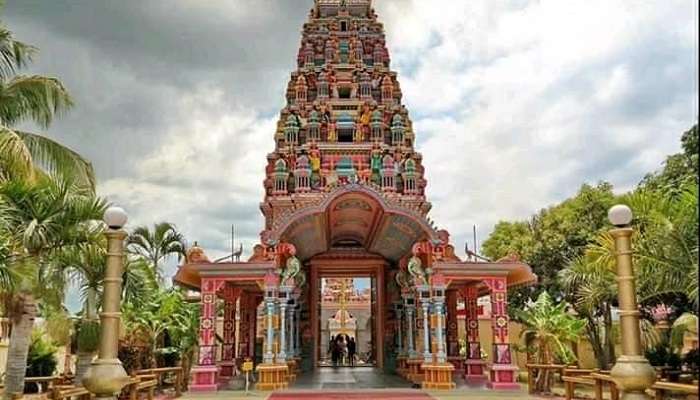
As with every temple we observe in South India, the Sockalingum Meenatchee Ammen Kovil also has some rules and regulations. Firstly, make sure that you wear only decent clothes to this temple. No short one-pieces, skirts or mini-skirts are allowed. You may refrain from any costume that exposes body parts. When entering the premises of this temple, make sure that you respect the silence and meditation being done by visitors present. Many people come here to meditate and find solace and you should not disturb them.
If you are visiting with kids, make sure that they maintain the decorum of the temple. One must always stay respectful of all the customs followed inside the temple. You should also follow and respect the rites here at all times. Another important thing to note here is that at Sockalingum Meenatchee Ammen Kovil, it is customary to take off your sandals or any other footwear when entering this place. This is to honour the place as it is a holy spot of prayer and religion.
Further Read: Indian Restaurants In Mauritius
From colourful statues to a serene atmosphere and religious essence to a peaceful ambience, Sockalingum Meenatchee Ammen Kovil bestows magic that is unheard of. When you plan your trip to Mauritius , make sure that you include the visit to this temple in your itinerary. The temple represents a unique combination of ancient architecture and modern spiritual living in a way that makes you wonder why haven’t you visited it before.
For our editorial codes of conduct and copyright disclaimer, please click here.
Cover Image Source: Shutterstock
Frequently Asked Questions About Sockalingum Meenatchee Ammen Kovil
Is Sockalingum Meenatchee Ammen Kovil is a fun visiting?
Yes, the temple is actually worth visiting. The uniquely built structure and the ancient stories attached to this complex give you a different viewpoint of Hindu and Tamil culture.
How long does it take to tour all of the Sockalingum Meenatchee Ammen Kovil?
The temple is fairly small. You won't have to travel much to see the entire complex. In total, it will take a maximum of 1 to 2 hours to completely visit and tour the temple. However, you can stay here for meditation and prayer. The short time to explore this temple makes it a more apt option to visit during your trip to Mauritius.
Which is the most popular Hindu Temple in Mauritius?
With a history spanning more than 130 years, it is the most revered Hindu temple in Mauritius. This temple features mostly Bengali temple architecture as its founder is from Calcutta.
How many Hindu temples are there in Mauritius?
As of April 2024, there are a total of 302 Hindu temples in Mauritius.
Is Mauritius beautiful?
Yes, it is. If you're searching for the ideal Indian Ocean getaway to unwind, Mauritius is the spot for you. With its powdery sand beaches, blue oceans and softly swaying palm trees in the breeze, Mauritius has everything you might want in a tropical vacation spot.
People Also Read:
Thien Hau Temple Lempuyang Temple Masceti Temple
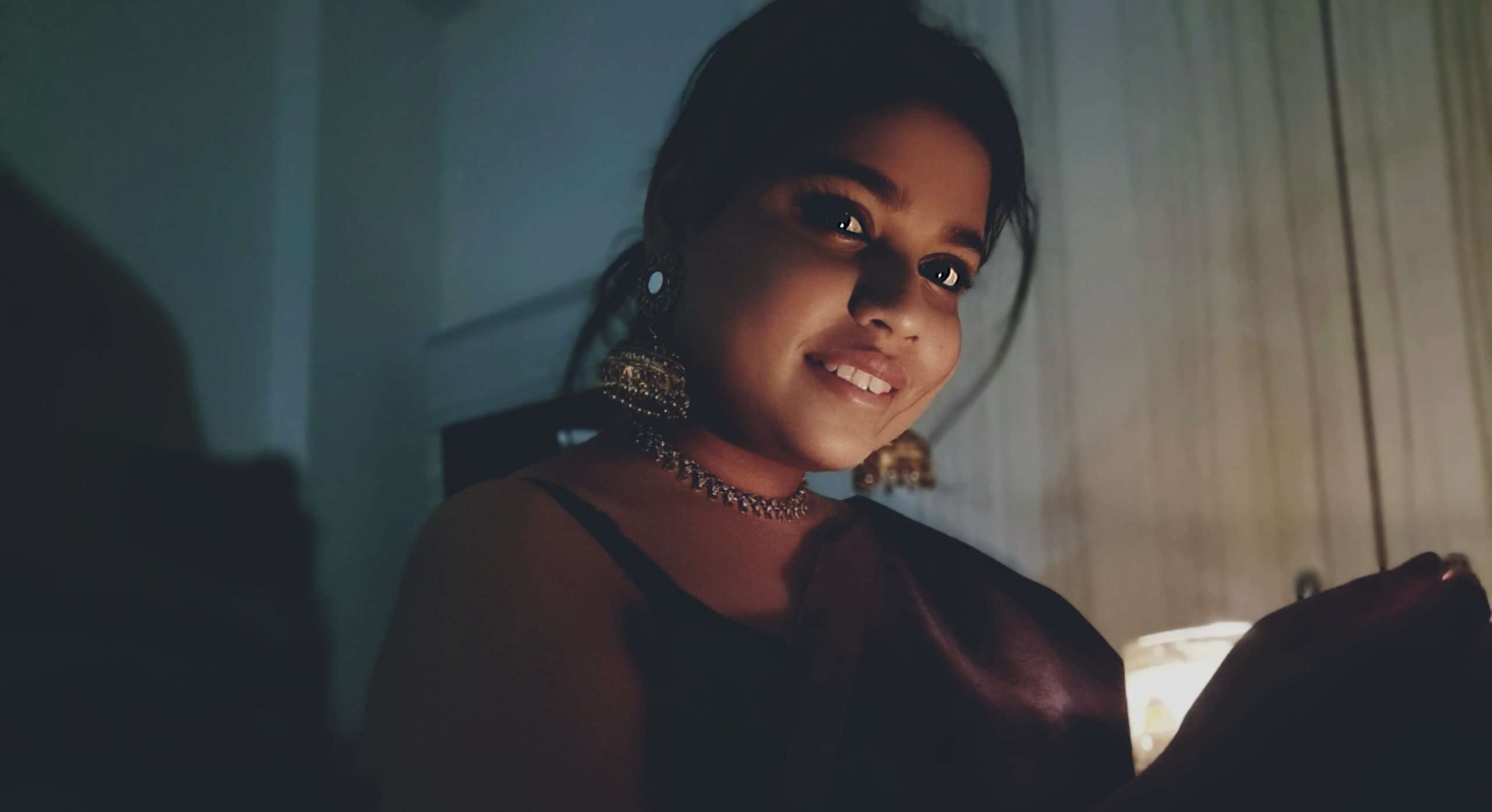
As a Travel Content Writer, I live to conquer the world of globetrotting with words. With my unquenchable thirst for storytelling, I believe that my words will inspire you to travel around the world’s breathtaking landscapes. As for me, I am an unapologetic selenophile, who loves to wander around in a starry night!











